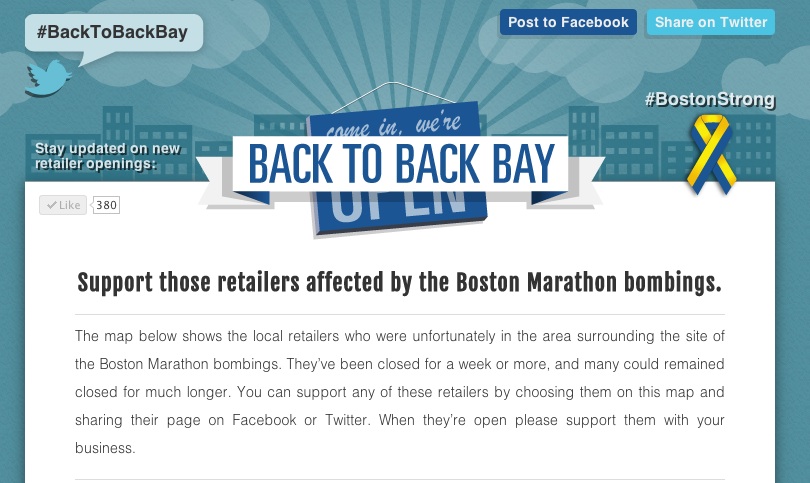Behind #BacktoBackBay’s Unofficial Website
With Boylston Street reopened Wednesday morning, people spent the day promoting a movement to bring consumers #BacktoBackBay (to borrow the language of Twitter). Boylston businesses and their sympathizers want to help offset the huge losses that hit owners and employees whose workplaces have remained shuttered since last week’s bombing. Amid the push, people began sharing a “Back to the Back Bay” website over Twitter and Facebook that provided a map of businesses in the area as well as links to stores’ websites and social media accounts.
The website was built by PromoBoxx, a local brand-to-retailer marketing firm that wanted to use their expertise helping big brands launch online marketing campaigns with their retailers to help Boston businesses recover from the setback. Servers, bartenders, and staffers who get paid by the hour reported losing hundreds of dollars in income in the past week. Amid the much greater losses of those injured or killed in the attacks, those smaller hardships can get lost in the shuffle. “We’re happy to help in a small way create awareness for these people,” says PromoBoxx CEO Ben Carcio.
Though the company had seen a #BacktoBackBay movement start to spread on social media in the past week, there wasn’t any central organizer coordinating the movement, so PromoBoxx’s people decided to build the website independently.
On the site, you’ll find a map with the area’s various businesses. Carcio says the site didn’t attempt to research who was closed and who remained open after the attack, but just focused on any businesses in about a one block radius. In addition to the hundred-some businesses they included when the site launched, there’s a tool that allows other businesses to add their names and information to the site. From the map, users can click through to a page highlighting a specific store, and if they want information on whether it has reopened or whatnot, businesses can comment on that page, or users can navigate through to that business’s website or social media accounts.
“We talked about the notion of indicating who was open and who was closed [on the site itself] but we felt that if we didnt have accurate info, that could be a bad thing,” Carcio says. “Our whole concept is: use the website. We have links to their Facebook page, a link to their Twitter feed, and it allows you to find out through those means.”
If you live in the Back Bay or walk Boylston Street regularly, you might not need the tool. After all, it’s basically just a tricked out map of Boylston Street. But it’s the others … those who don’t head this direction as often but want to help with the recovery, Carcio says, who might find it useful.
“It’s like, ‘Oh yeah, I forgot that such-and-such was on Boylston Street. That, I think, is what we’re trying to do. Scan the list, jog your memory, and say, ‘Oh yeah,'” he says.




